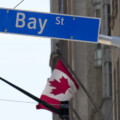Today in Canada, the promise of shared prosperity and equitable growth is fading amidst escalating challenges. Our country is grappling with the fallout from a record surge in temporary immigration, pushed through without debate at the behest of influential business interests without adequate planning for infrastructure, housing, or social capacity. Construction costs and timelines for these social goods, from housing to transit to hospitals, have ballooned to comical levels.
Meanwhile, petty crime is rising as community trust erodes, homelessness is multiplying, and the cost of living has skyrocketed post-pandemic. Unemployment is inching up, especially among young adults who increasingly see the “Canadian Dream” as out of reach.
For Canada’s middle class, life has become an endless gauntlet. The economy is dominated by oligopolies that disregard innovation, quality, and value. The government seems intent on increasing taxes while their ability to actually deliver public goods declines toward developing-world standards.
Amid this backdrop, the powers that be have lost touch with the systems and opportunities that once buoyed the middle class. How did we reach this precarious cliff edge? Why do cries for systemic improvements feel like screaming into the void?
Regulatory capture has rigged our economy
Peeling back the layers reveals the pervasive influence of regulatory capture—a phenomenon that not only explains the erosion of public goods but also exposes why the Canadian economy feels rigged against its citizens.
Powerful corporations dominate major sectors, leaving small businesses and new competitors struggling to launch and survive. Simultaneously, wealthy and often older residents influence housing and growth policies to their advantage, marginalizing younger, newer, and less privileged Canadians. This entrenched system ensures that prosperity remains out of reach for those without established influence or wealth.
The real cunning of this regulatory capture lies in its complexity and the diffusion of accountability. By spreading responsibility for regulatory initiatives across multiple groups—politicians, government agencies, established corporations, professional consultants, and lawyers—identifying a single culprit for the failing systems becomes nearly impossible for middle-class voters.
A smokescreen of complexity and bureaucratic jargon ensures that when systemic outcomes falter, pinpointing blame is as challenging as navigating the regulations themselves. Such a scenario leaves citizens disempowered and disenfranchised, struggling to advocate for change in a system that obfuscates responsibility at every turn.
Regulatory capture extends far beyond overt lobbying. Entrenched industry players influence regulations to suit their interests, with the largest wielding significant political influence that can secure legislative favours. This manipulation creates significant complexity for potential competition, forming barriers that limit participation to those who can afford legions of lawyers and consultants. The “cottage industry tax” this imposes bars newcomers and those lacking substantial financial resources, stifling innovation and limiting consumer choices. It reinforces the economic stagnation now familiar to Canadians.
Regulatory development often begins with genuine intentions to address specific challenges, but the process is deeply flawed. State bureaucracies, lacking niche expertise, often rely on consulting firms and industry stakeholders, who provide feedback to align with their interests. This results in regulations favouring established players while neglecting the interests of the broader public and future potential competitors.
Consequently, these rules entrench existing powers and introduce complexities that justify expanded bureaucratic scope and boost the inherent value of professional expertise to navigate processes. Ultimately, all participating parties benefit, while neglecting broader systemic impacts, resulting in a regulatory landscape that increasingly fails to secure outcomes in the public good.
Counterintuitively, increasingly intricate bureaucratic processes—whether regulatory or service-related—create fertile ground for soft corruption that is hard to identify and even harder to hold people accountable for. Excessive layers of rules and procedures obscure transparency, allowing vested interests to navigate and bend the system to their advantage, while the public remains in the dark. Look no further than the ArriveCAN scandal, which uncovered that firm GC Strategies had been awarded over $100M in federal government contracts since 2017, despite having just two employees. In the aftermath of parliamentary hearings, NDP MP Blake Desjarlais astutely concluded that “a massive web of subcontractors is sucking out tons of money from the public service.” The very complexity designed to ensure thoroughness and fairness instead makes it near impossible to provide true oversight, fostering an environment antithetical to genuine progress that disadvantages the economically marginalized and undermines public trust.

People look on as an Air Canada plane takes off at Trudeau Airport in Montreal, Sunday, June 11, 2023. Graham Hughes/The Canadian Press.
A captured economy costs us middle-class prosperity
The insidious nature of regulatory capture is starkly evident in Canada’s housing sector. Escalating costs have shattered the dream of homeownership for young Canadians without family wealth. Long-time homeowners have influenced politicians to impose restrictive zoning laws, place stringent limitations on greenfield development, and maintain arduous processes that throttle supply. Moreover, the demand to maintain low property taxes has encouraged a generation of politicians to impose exorbitant taxes on new housing. Given Canada’s rapidly growing population, this drives up the prices of existing housing until new builds can be justified at an artificially high price floor.
These increasingly unjustifiable restrictions on new housing encourage speculators and counterintuitively benefit the largest developers, who can afford the lengthy timelines and armies of consultants required to navigate the system. They out-compete smaller developers for scarce land and enjoy predictable market prices due to consistent supply constraints. This reduction in competition allows them to avoid the need to improve quality or reduce prices. Small and medium-sized developers, who could diversify housing options and lower costs through competition, are shut out by high compliance burdens and the scarcity of developable land, rendering their projects infeasible.
Housing is just one example of regulatory capture in Canada. The telecommunications industry, dominated by Bell, Rogers, and Telus (representing 89 percent of the market), faces high barriers to entry. Onerous foreign ownership rules and CRTC regulatory decisions often favour incumbents, such as setting high wholesale rates for network access and delaying spectrum allocation decisions. In banking, stringent OSFI regulations reinforce the dominance of the “Big Five” banks that control a 90 percent market share, hindering provincially regulated banks and credit unions from accessing new markets and imposing high entry costs on global banks.
Similarly, provincial health-care policies limit the number of doctors through caps on medical school admissions, restrictions on international medical graduates, billing caps, and limited residency positions, benefiting established medical professionals (not to mention provincial budgets) while restricting much-needed nurse practitioners, midwives, and international graduates.

A customer takes a jug of milk from a cooler at a grocery store in Airdrie, Alta., on Tuesday, Aug. 30, 2016. Jeff McIntosh/The Canadian Press.
The aviation sector also faces high barriers to entry due to controlled landing slots and airport fees, favouring carriers like Air Canada and WestJet (85 percent market share). Interprovincial trade barriers impact industries such as alcohol, dairy, and construction, protecting well-connected provincial businesses but inflating consumer prices by an estimated seven percent. The heavily regulated dairy industry uses supply management to control production and prices, benefiting producers but burdening consumers with higher costs. This one system complicates nearly every free trade negotiation Canada has pursued, resulting in potentially significant trade-offs in foreign market access for competitive Canadian industry.
The omnipresent reality of regulatory capture necessitates a race to the bottom for all private industry, resulting in relentless competition to influence legislators, regulators, and bureaucrats to implement policies that advantage their businesses. It has spawned a plethora of industry advocacy organizations and record lobbying efforts, making this state of affairs so “normal” that Canadians treat it as business as usual. Ironically, the pursuit of regulatory favour has become the most competitive aspect of Canada’s otherwise mediocre private economy.
Canada’s economy is ready to shine
The challenge of regulatory capture is, in some ways, good news. Unlocking greater economic performance through reform is entirely possible because the fundamentals of Canada’s economy are inherently favourable to growth. With a highly educated population, comprehensive social freedoms, geopolitical safety, abundant natural resources, and an advantageous trade relationship with the U.S., Canada has the potential for robust economic dynamism.
Comprehensive reforms that simplify regulations, promote transparency, strengthen anti-trust laws, and bolster state capacity to deliver public goods can unleash this potential. Simplification should not be mistaken for a call for smaller government. Instead, it is a plea for a government that focuses on big-picture outcomes as a priority.
Citizens must demand more discipline from their elected officials, emphasizing the importance of creating fair, open, and competitive markets complemented by robust public services that guarantee choice for citizens. By resisting the demands of entrenched stakeholders and focusing on genuine systemic improvements, we can pave the way back to rising prosperity for all Canadians.
Recommended for You

‘Another round of trying to pull capital from Canada’: The Roundtable on Trump’s latest tariff salvo

‘We knew something was coming’: Joseph Steinberg on how Trump is ramping up his latest tariff threats against Canada

Rudyard Griffiths and Sean Speer: Canada’s high-stakes standoff with Trump

Canada is losing ground on investment. Here’s where





